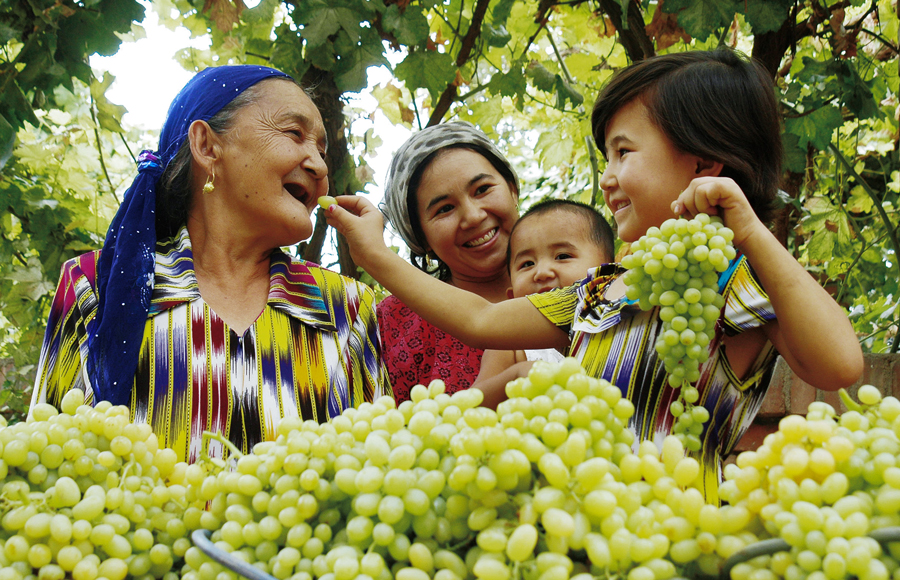Published:September 04,2022
By Adnan Akfirat

A Uygur family harvests ripe grapes in Turpan, Northwest China’s Xinjiang Uygur autonomous region. [Photo/People’s Daily Online]
My first trip to China’s Xinjiang Uygur autonomous region was in 2004. I have visited Urumqi, Turpan, and the Ili Kazakh autonomous prefecture in northern Xinjiang and have been impressed by the development of Urumqi, the network of “Karez canals” or underground irrigation canals in Turpan, and the natural beauty of Ili. On my dozens of trips Xinjiang, I have visited many places including Kashgar, Hotan, Aksu, Altay, Shihezi and Karamay.
On July 4-9, I led a tour delegation of foreign trade representatives in China to Xinjiang. The tour was organized by the Foreign Economic Cooperation Center of the International Relations Department of the Communist Party of China Central Committee.
During this trip, we visited Urumqi, Turpan and Ili. In Ili, we stayed at the same hotel that hosted us in 2004. The hotel was the same but the building was new. The former Soviet Union consulate building was converted into a hotel after the founding of the People’s Republic in 1949, though the old building was razed two years ago and a new one built in its place. However, the large garden and centuries-old trees were left untouched, with only the bust of Lenin being moved from inside the hotel and placed at the outer entrance.
What came as a pleasant surprise is that the Ili local Party chief and government head both are women. Competent, hardworking and elegant, they have turned Ili into a tourist attraction, complete with lavender fields at the foot of Tianshan Mountains and the Accordion Museum where live concerts are performed by people from five different ethnic groups.
As for Turpan, its most famous product is grape, with Turpan resins being famous across the world. The oldest records of grape cultivation in the region date back 2,000 years, and today, Turpan accounts for about one-fifth of China’s total grape production.
But tourism is so developed in the region that many vineyard owners earn more from tourism than by growing or processing grapes. In fact, the winery we visited in Turpan has a kilometer-long tunnel and also serves as a hotel with barrel-shaped rooms.
The most vital tourist attraction in Turpan is, of course, the Turpan Karez System Museum. The Karez network of hundreds of underground canals is used to carry water from underground rivers and lakes to the city, which is about 50 meters below the sea level. According to records, the Karez system of channeling water dates back 1,200 years.
On Sept 23-27, 2021, the Foreign Economic Cooperation Center organized a tour for foreign trade representatives in China to Hotan and Aksu. Visiting Hotan after 10 years, I could not believe my eyes. The dusty streets and single-story houses had been replaced by a clean, orderly city. But the stone buildings have been carefully preserved as cultural and architectural heritage and turned into tourist attractions. Indeed, poverty in southern Xinjiang was eradicated by developing tourism and reviving cooperative farming. Thanks to the people’s efforts and indomitable spirit, Aksu and Hotan have turned into huge oases on the edge of a vast desert.
Socialism with Chinese characteristics has played the key role in lifting people out of absolute poverty and bringing development and relative prosperity to the mountainous and arid region.
I realized the level of development in Xinjiang when I attended a Uygur wedding in Almaty, Kazakhstan. I was startled by the feudal norms still being practiced by the Uygurs in Kazakhstan that grant little or no rights to women and children.
But in China, thanks to socialism with Chinese characteristics, the Uygurs, including Uygur women, can study the subjects of their choice, as well as master and develop their language, enrich their culture and modernize themselves by learning from the progressive aspects of Islam. One of the strengths of socialism with Chinese characteristcs is that it promotes the cultural blending of 56 ethnic groups.
China regards diversity, both natural and social, as wealth. Only China can rightly evaluate the true worth of 1.66 million square kilometers of deserts and mountains and treat them as wealth. But for that they have to be accessible. So China has built a vast network of expressways and railways which crosses deserts and tunnels through or circumnavigates mountains. It has also 22 airports in Xinjiang to facilitate intra-region and inter-region travel and boost tourism.
No wonder despite the COVID-19 pandemic, Xinjiang received more than 191 million tourists in 2021, up 20.5 percent year-on-year.
Due to the central and local governments’ arduous efforts, Xinjiang no longer is threatened by terrorism. Instead, visitors see a prosperous and stable region. Diverse geographical features, rich ethnic cultures, and different and unique local cuisines have made tourism one of Xinjiang’s core industries. Also, the improved transport network has made traveling in this vast region much easier. For example, you can have a traditional Kazakh breakfast on the Narat grasslands in Ili in the morning, and sip your afternoon tea at the centuries-old tea house in Kashgar old town.
Visit Xinjiang to see the fascinating region with your own eyes and realize what kind of magic socialism is for development.
The author is deputy head of the International Relations Bureau of Vatan Party (Turkiye), and a visiting researcher at the Silk Road Research Center, Shihezi University.
China Daily
 Africa -China Review Africa -China Cooperation and Transformation
Africa -China Review Africa -China Cooperation and Transformation
